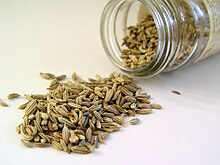Good heavens. Why, I've known about juga for about...oooh...at least five and a half seconds.
Although a jugum sounds like a sweet made for Alice while in Wonderland, in fact there are juga all over the place. You'll probably be close to some every day unless you live somewhere extremely cold and eat only very plain food.
A jugum can be one of the ridges found on the seeds of umbelliferous plants.

That's hogweed. (An umbelliferous plant is one that has that sort of cow parsley/Queen Anne's lace type flower.) Sorry the labels are in French.
And if it's not the season for flowers where you are then not to worry because the kitchen cupboard may well provide a glimpse of juga.

Fennel seeds. Caraway, celery and dill are umbelliferous plants, too, so their seeds should display juga.
A jugum can also be a pair of opposite leaflets:

Blechnum appendiculatum
As if that's not enough for one small word to do, jugum also describes the mechanism some moths use to fix their fore and hind wings together when they want to fly, and a fold in the membrane at the base of a beetle's wing.
Juga, juga, everywhere.
It really makes the world an even more wonderful place once you know.
Doesn't it?
Spot the frippet: jugum. This word is the Latin word for yoke.
Had to look up umbelliferous, very nice. Introduced to the giant Hogweed by Genesis, which lead me to believe it was a more frightening form of Triffid, quite disappointed by the real thing in Kew.
ReplyDeleteWelcome to The Word Den, and thanks very much for commenting, Unknown.
DeleteIt must come from writing fantasy, but I read what you'd written as Giant Hogweed to start with, and got quite excited.
But I know just what you mean. I felt much the same way when I discovered that sea horses were too small to ride on.